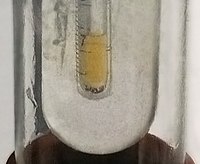
Photo from wikipedia
BACKGROUND The urine metabolites and chemistries that contribute to kidney stone formation are not fully understood. This study examined differences between the urine metabolic and chemistries profiles of first-time stone… Click to show full abstract
BACKGROUND The urine metabolites and chemistries that contribute to kidney stone formation are not fully understood. This study examined differences between the urine metabolic and chemistries profiles of first-time stone formers and controls. METHODS High-resolution 1H-nuclear magnetic resonance (NMR) spectroscopy-based metabolomic analysis was performed in 24-hour urine samples from a prospective cohort of 418 first-time symptomatic kidney stone formers and 440 controls. In total, 48 NMR-quantified metabolites in addition to 12 standard urine chemistries were assayed. Analysis of covariance was used to determine the association of stone former status with urine metabolites or chemistries after adjusting for age and sex and correcting for the false discovery rate. Gradient-boosted machine methods with nested cross-validation were applied to predict stone former status. RESULTS Among the standard urine chemistries, stone formers had lower urine oxalate and potassium and higher urine calcium, phosphate, and creatinine. Among NMR urine metabolites, stone formers had lower hippuric acid, trigonelline, 2-furoylglycine, imidazole, and citrate and higher creatine and alanine. A cross-validated model using urine chemistries, age, and sex yielded a mean AUC of 0.76 (95% CI, 0.73 to 0.79). A cross-validated model using urine chemistries, NMR-quantified metabolites, age, and sex did not meaningfully improve the discrimination (mean AUC, 0.78; 95% CI, 0.75 to 0.81). In this combined model, among the top ten discriminating features, four were urine chemistries and six NMR-quantified metabolites. CONCLUSIONS Although NMR-quantified metabolites did not improve discrimination, several urine metabolic profiles were identified that may improve understanding of kidney stone pathogenesis.
Journal Title: Journal of the American Society of Nephrology : JASN
Year Published: 2022
Link to full text (if available)
Share on Social Media: Sign Up to like & get
recommendations!